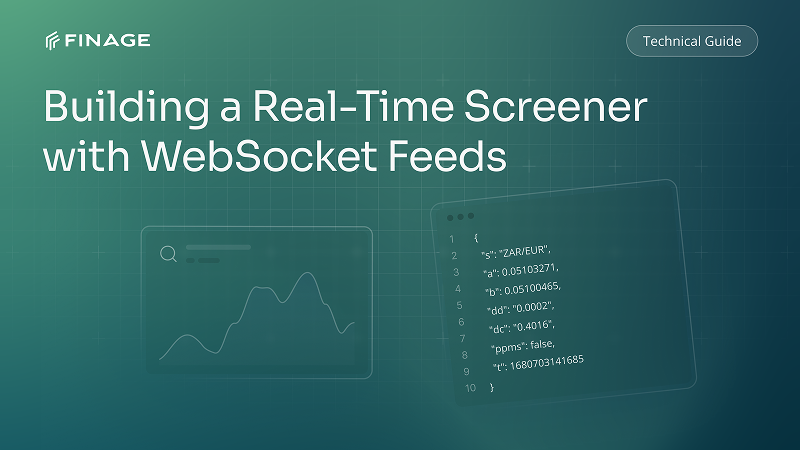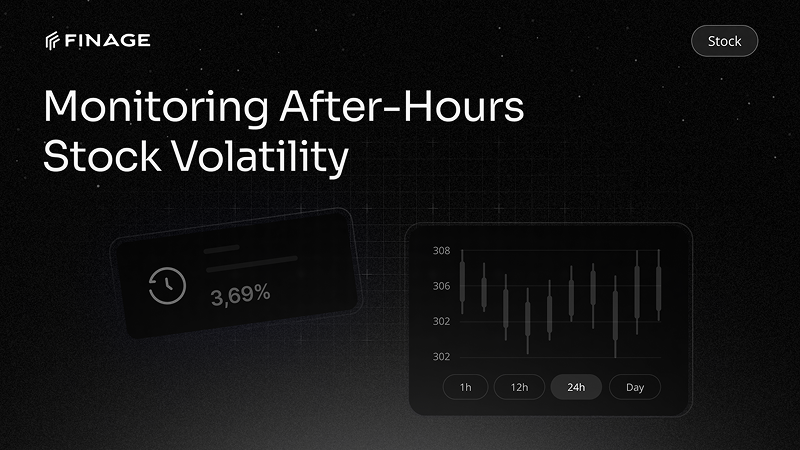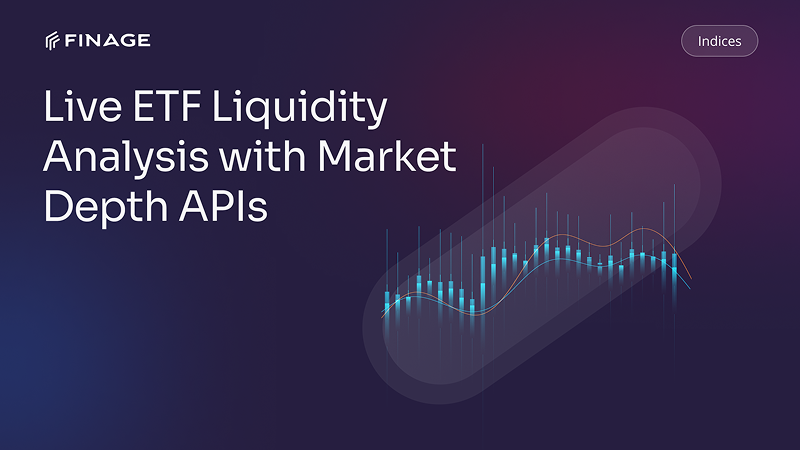Building Custom Indicators with Historical Financial Data APIs
13 min read • June 18, 2025

Introduction
Custom indicators allow traders, developers, and quants to gain a unique edge, whether through original signals, alternative data patterns, or modified versions of standard technical tools. But building indicators from scratch requires more than just a formula. It starts with structured, high-integrity historical data.
Financial data APIs make this process accessible and scalable. With reliable historical prices, volume, and other time-series data, you can design indicators that are tailored to your strategy, not limited by off-the-shelf solutions.
In this article, we’ll walk through how to use historical financial data APIs to build, test, and refine custom indicators. We’ll look at the kinds of data to request, how to transform them into features, and what to consider when validating your results over time.
Table of Contents
- Why Custom Indicators Matter
- Choosing the Right Historical Data for Your Use Case
- Structuring Your Time-Series Inputs
- Common Transformations and Feature Engineering Techniques
- Using Rolling Windows for Smoothing and Signal Creation
- Validating Your Indicator with Historical Backtesting
- Avoiding Overfitting in Custom Indicator Design
- Integrating with Trading Systems or Dashboards
- Infrastructure Tips for Scalable Indicator Generation
- Final Thoughts: Building Smarter with Finage Data
1. Why Custom Indicators Matter
Most traders and analysts are familiar with common technical indicators like moving averages, RSI, MACD, and Bollinger Bands. These tools are widely available and built into nearly every trading platform—but they’re also widely used, which means their predictive edge tends to diminish in efficient markets.
Custom indicators offer an opportunity to go beyond the obvious. By combining data differently, applying new logic, or incorporating alternative signals, developers can create proprietary indicators that reflect their own market insights. These may include:
- Modified versions of classic indicators (e.g., smoothed RSI, multi-timeframe MACD)
- Price-action-based signals tuned to specific assets
- Volume or order-flow sensitive tools for short-term trading
- Multi-source indicators blending fundamental and market data
- Machine-learning–driven composites that adjust dynamically
The key is control. When you design your own indicators, you're not just choosing what to measure—you're deciding how to measure it, and why it matters. This leads to strategies that are more aligned with your specific goals, risk tolerance, and style of execution.
But to create indicators that are both useful and statistically sound, you need access to accurate, granular historical data—ideally with enough depth and consistency to capture real patterns over time.
2. Choosing the Right Historical Data for Your Use Case
Not all historical data is equally valuable, and the type you choose will directly shape the behavior of your custom indicators. Whether you're building for short-term signals, long-term portfolio metrics, or strategy backtesting, aligning your data choice with your end goal is critical.
Price data
For most technical indicators, historical price data—such as open, high, low, close (OHLC)—is the starting point. Depending on the resolution of your strategy, you may need:
- Minute-level data for intraday signals or high-frequency logic
- Hourly or daily candles for swing or medium-term strategies
- Weekly or monthly aggregates for trend-following or macro filters
Make sure your data source includes consistent timestamps, properly aligned time zones, and clearly labeled price fields.
Volume and trade data
Volume is often used as a confirmation tool—rising volume can validate breakouts, while declining volume may signal weakening trends. If your strategy involves identifying liquidity shifts, you’ll need historical volume per period, and possibly tick-by-tick data for more precise indicators.
Market depth and order book history
For more advanced custom indicators—especially those involving execution optimization or short-term momentum—access to historical Level 2 data can be a game-changer. While not always available from every API, it provides deeper insight into supply and demand at multiple price levels.
Alternative or fundamental data
Some developers enrich their custom indicators with:
- Economic calendars and earnings reports
- Sentiment scores or social media trends
- Corporate fundamentals or tokenomics in crypto
- Macroeconomic indicators (interest rates, inflation data)
Historical APIs that provide these inputs allow you to build context-aware indicators that respond not just to prices, but to the forces shaping them.
3. Structuring Your Time-Series Inputs
Once you’ve chosen the right dataset, the next step is to prepare it in a way your indicator logic can interpret reliably. Poor structure leads to noisy inputs and unstable outputs—especially in financial time series where even small misalignments can distort results.
Use a consistent time interval
Decide on a uniform time granularity—whether it's one minute, five minutes, one day, or another timeframe—and resample your data accordingly. Irregular intervals or missing timestamps can confuse calculations like rolling averages, standard deviations, or cumulative measures.
If you're working with APIs that return tick or irregular trade data, you'll often need to aggregate this into consistent candles or time buckets before using it in any indicator.
Align fields across instruments
If you're building multi-asset indicators (e.g., spread indicators, correlation measures), you need your datasets to be time-aligned. That means every timestamp in asset A must match a timestamp in asset B, with no gaps or offset values.
This often requires filling missing timestamps with either:
- Forward-fill (last known value) for indicators that require continuity
- Null or zero where intentional gaps matter (e.g., volume-based signals)
Handle missing and outlier data
Outliers—like incorrect spikes in price or volume—should be cleaned before running indicator logic. Use rolling z-scores or hard-coded bounds to flag and remove invalid data points.
For missing values, be deliberate. Some indicators are sensitive to gaps (e.g., RSI or MACD), and improperly filled data can cause sudden shifts. In many cases, it's better to drop rows or use conservative interpolation than to introduce artificial patterns.
Normalize or scale where needed
If your indicator compares across instruments or applies mathematical models (e.g., PCA, clustering), normalize the values to a common scale. Techniques like min-max scaling or log transformation help maintain interpretability across different price ranges.
4. Common Transformations and Feature Engineering Techniques
At the heart of every custom indicator is a transformation—an operation that extracts something meaningful from raw market data. Whether you're smoothing prices, comparing changes over time, or combining variables, the features you design define the character of your indicator.
Price-based transformations
The simplest and most common involve transforming price fields into smoothed or comparative metrics. Examples include:
- Moving averages (simple, exponential, weighted): foundational for trend detection
- Rate of change: percentage difference between prices over a fixed window
- Price differentials: such as close minus open, or high minus low (range indicators)
These transformations provide directional context and momentum insight.
Volatility and dispersion
To gauge market uncertainty or signal potential breakouts, many indicators incorporate volatility measures:
- Rolling standard deviation of returns or price changes
- Average True Range (ATR) to assess historical price movement
- Bollinger Bands as dynamic support/resistance zones based on deviation
These features add risk sensitivity to your signals.
Volume and liquidity metrics
Volume-based features can confirm the strength or weakness of a price move:
- Volume moving averages to smooth irregular activity
- Volume spikes relative to previous rolling windows
- On-balance volume (OBV) for directional strength of volume flow
Some custom indicators even blend price change with volume, generating weighted momentum signals.
Normalization and ratios
To make comparisons across time or assets more meaningful, it’s common to build features like:
- Relative strength indicators (e.g., current value vs. max/min of past N periods)
- Z-score normalization for identifying statistical extremes
- Rolling percentiles or quantile bands for adaptive range tracking
These techniques can help your indicators respond dynamically to changing market regimes.
5. Using Rolling Windows for Smoothing and Signal Creation
Rolling windows are a core tool in time-series analysis. They allow you to apply calculations over a moving subset of data—creating indicators that respond to recent trends while filtering out short-term noise. Most custom indicators rely on this approach for smoothing, normalization, or detecting changes in direction.
Moving averages
One of the most common uses of rolling windows is the moving average. Whether simple (SMA), exponential (EMA), or weighted (WMA), these indicators summarize price behavior over a specific lookback period.
By adjusting the window size, you control how reactive or stable your indicator is:
- Shorter windows (e.g., 5–10 periods): capture recent price momentum
- Longer windows (e.g., 50–200 periods): define broader trends and reduce noise
Moving averages are often combined—like in crossover systems where a short-term average crossing a long-term average signals trend shifts.
Rolling volatility
Volatility indicators use rolling windows to measure the dispersion of price over time. For example:
- Rolling standard deviation helps assess how much prices are fluctuating
- Rolling ATR (Average True Range) adds context to candles, especially during consolidations or breakouts
These features can make your indicator sensitive to market regime shifts—helping to filter false signals in high- or low-volatility conditions.
Rolling ranks and percentiles
Instead of using raw values, some indicators work better when framed in relative terms. For example:
- “Is today’s close in the top 10% of the last 30 days?”
- “Is volume above its 20-day median?”
Rolling ranks and percentiles smooth data in a way that adjusts to different market environments—especially helpful for range-bound strategies.
Rolling correlation or relationships
You can also apply rolling windows to measure how two assets interact over time. For example:
- Rolling correlation between stock and sector index
- Spread indicators using the rolling difference between two related instruments
These types of indicators are popular in pair trading, hedging strategies, and mean-reversion models.
6. Validating Your Indicator with Historical Backtesting
Designing a custom indicator is only the first step. To know whether it actually works—whether it delivers meaningful, actionable signals—you need to test it. Backtesting allows you to apply your indicator to historical data and evaluate how it would have performed under real market conditions.
Define your objective
Before running a backtest, clarify what you want your indicator to do. Are you looking for:
- Entry/exit signals for trades?
- Trend confirmation?
- Risk management alerts?
- Divergence identification?
Clear intent helps structure your test logic and determine relevant performance metrics.
Set your signal rules
Indicators become useful when combined with rules. For example:
- Buy when the indicator crosses above a certain threshold
- Sell when a short-term average falls below a long-term average
- Exit when volatility exceeds a recent range
These rules define how your indicator generates tradeable or actionable outcomes—and they should be consistent during testing.
Run simulations across multiple periods
Apply your indicator to several timeframes, market conditions, and asset types. A good custom indicator should:
- Work consistently (not just on one specific stock or time window)
- Show resilience in different volatility regimes
- Avoid strong performance only in hindsight
Be cautious of overfitting—where your indicator performs well in historical data but fails in real time due to being too finely tuned.
Measure relevant metrics
Depending on your use case, useful metrics might include:
- Signal win rate or success ratio
- Average gain/loss per trade
- Drawdown and risk-adjusted returns (if used in trading)
- Lag, stability, or false positive rate (if used for confirmation)
The key is to align your evaluation with your original intent—not all indicators are built to maximize profits. Some are designed to reduce noise or increase clarity in portfolio monitoring.
7. Avoiding Overfitting in Custom Indicator Design
Overfitting happens when a custom indicator is tailored too closely to the specific quirks of historical data. While it may look great in backtests, it often fails when exposed to new, real-time market conditions. Avoiding overfitting is key to creating indicators that generalize well and actually deliver value in production.
Keep it simple
The more conditions, parameters, or rules you add to an indicator, the more likely it is to perform well in-sample—and fail out-of-sample. Simpler indicators tend to be more robust across different environments. Ask yourself: does each additional layer meaningfully improve signal quality?
Limit parameter tuning
Excessively optimizing input lengths, thresholds, or coefficients can produce impressive historical charts but misleading confidence. Instead:
- Use broad, intuitive ranges (e.g., 20-day vs 21-day RSI rarely makes a major difference)
- Validate performance across multiple parameter sets, not just the best one
- Consider parameter-free indicators (e.g., ranking-based methods)
Test across timeframes and assets
An indicator that only works on a single stock or over a narrow time window is a red flag. Broaden your testing scope to include:
- Bull and bear markets
- High- and low-volatility periods
- Multiple instruments (stocks, ETFs, crypto, etc.)
Look for consistency—not perfection—in results.
Use walk-forward and out-of-sample testing
Instead of testing on all available data, split your historical data into:
- Training set (for design and calibration)
- Validation set (to refine without overfitting)
- Test set (to evaluate final performance)
Walk-forward testing, where models are re-evaluated and re-applied over multiple periods, is especially useful for indicator validation.
8. Integrating with Trading Systems or Dashboards
Once your custom indicator is designed and validated, it needs to be put to use—either by informing decisions in a dashboard, or powering execution logic in a live trading system. Integration isn’t just a technical step; it’s where your indicator proves its value in real-time decision-making.
API-based data flow
For real-time use, your indicator should be connected to a reliable data pipeline. This typically involves:
- Fetching live market data via API endpoints or WebSocket streams
- Applying your indicator logic as new data arrives
- Outputting signals or updates in a format consumable by your system
Using Finage APIs, for example, you can pull intraday price updates and apply your indicator logic incrementally, rather than recalculating everything from scratch on each tick.
Front-end visualization
For discretionary traders, visual representation matters. If you’re integrating into a dashboard or custom interface:
- Plot your indicator alongside price or volume charts
- Use color or shape to indicate signal states (e.g., bullish/bearish, overbought/oversold)
- Allow parameter toggling for experimentation or optimization
Interactive dashboards help validate the indicator’s behavior over time, and also make it easier to catch issues like lag or signal clustering.
Strategy automation
If your indicator feeds into automated strategies, integration must support:
- Real-time decision logic (e.g., trigger buy/sell conditions)
- Position and risk tracking
- Logging and audit trails for debugging or compliance
Here, latency, stability, and accurate timestamp alignment are critical. Even a highly accurate indicator can misfire if fed delayed or misaligned data.
Monitoring and retraining
As with any live system, your indicator integration should include:
- Performance logging (e.g., how often it triggers, how often signals are followed)
- Live monitoring for drift or instability
- Scheduled reviews for revalidation or retraining based on market changes
Indicators that perform well today may degrade as regimes shift—continuous evaluation keeps your tools sharp.
9. Infrastructure Tips for Scalable Indicator Generation
As your strategies grow, so does the demand on your data and computation pipelines. Whether you're managing dozens of indicators or supporting real-time dashboards across multiple assets, the right infrastructure ensures performance doesn't suffer under pressure.
Use modular indicator architecture
Separate your components into clearly defined layers:
- Data ingestion (API calls, data fetching, caching)
- Processing and transformation (rolling windows, smoothing, feature generation)
- Signal generation (logic, thresholds, directionality)
- Output handling (trading signals, dashboard updates, logging)
Modularity lets you update parts of the system independently—without breaking the entire flow.
Cache historical data smartly
Downloading full history from an API every time you calculate an indicator is inefficient. Instead:
- Cache historical data locally or in memory
- Update incrementally as new candles or ticks arrive
- Use time-indexed storage (e.g., with Pandas or InfluxDB) for faster lookups and transformations
This improves performance and reduces API call volume.
Optimize for incremental computation
Many indicators rely on rolling calculations. Rather than recalculating from scratch every time, update only the affected window as new data comes in. This reduces CPU usage and latency, especially in real-time systems.
Monitor performance at scale
As you deploy more indicators, keep an eye on:
- Memory usage and storage
- API rate limits (especially for high-frequency feeds)
- Latency from data ingestion to signal output
Build internal tools to track which indicators are active, how often they trigger, and whether they’re producing expected results.
Prepare for multi-asset expansion
If your infrastructure supports custom indicators on one symbol, scaling to 10 or 100 symbols introduces new load. Design with parallel processing, asynchronous data requests, and configurable asset lists to avoid performance bottlenecks.
10. Final Thoughts: Building Smarter with Finage Data
Custom indicators give traders and developers the flexibility to create exactly what their strategy needs—not just rely on predefined tools. But the success of any custom-built logic depends on the integrity of the data that feeds it. Clean, consistent, and complete historical data isn’t a luxury—it’s a prerequisite.
Finage supports this entire process by offering:
- Access to accurate historical OHLCV data across stocks, forex, crypto, indices, and more
- Real-time feeds for smooth integration into live indicator pipelines
- Normalized symbols and timestamps to reduce preprocessing overhead
- Scalable infrastructure for developers building custom dashboards, automated systems, or multi-asset tools
Whether you're creating a trend-following tool, a volatility-based filter, or an ML-driven composite signal, Finage APIs give you the data backbone to turn concept into execution.
You can get your Real-Time and Historical Market Data with a free API key.
Build with us today!
Claim Your Free API Key Today
Access stock, forex and crypto market data with a free API key—no credit card required.

Stay Informed, Stay Ahead
Finage Blog: Data-Driven Insights & Ideas
Discover company news, announcements, updates, guides and more


